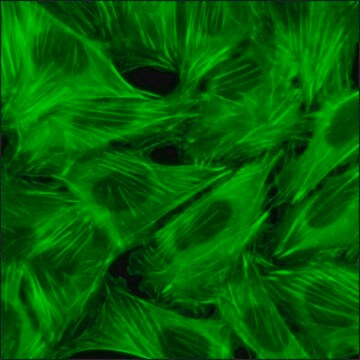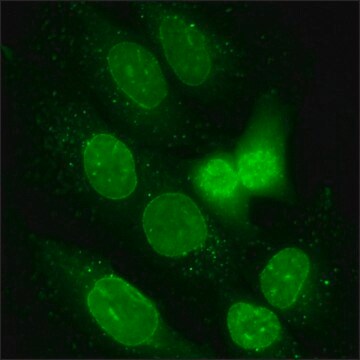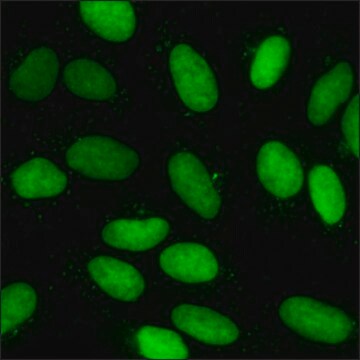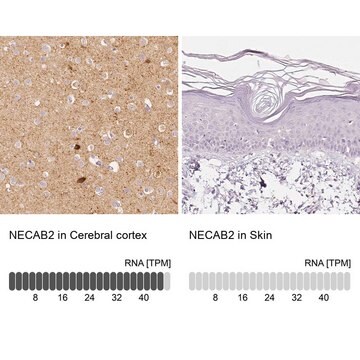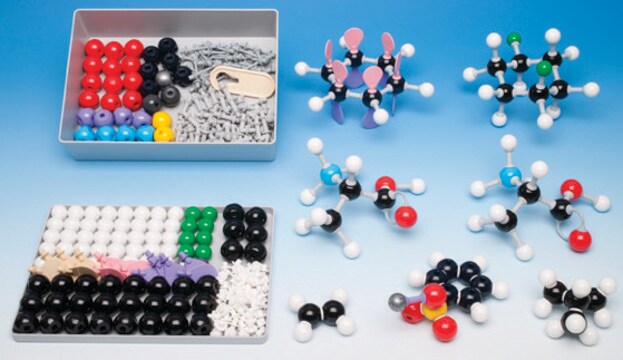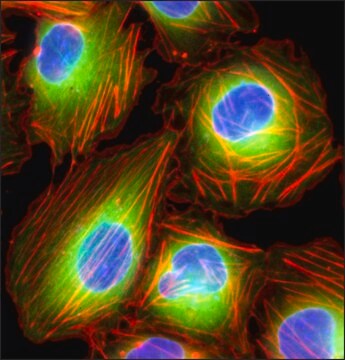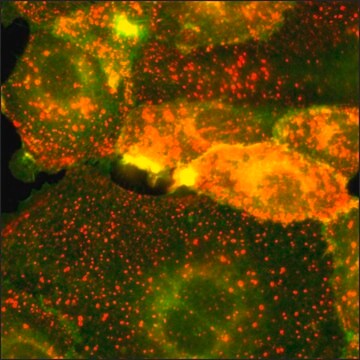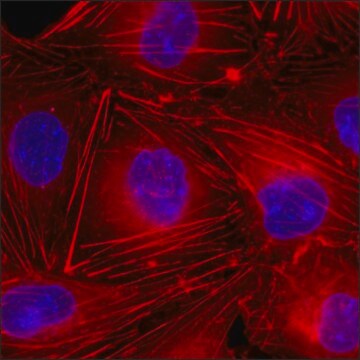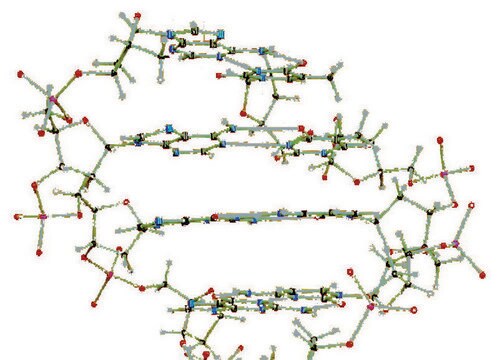Alle Fotos(4)
Wichtige Dokumente
CLL1037
U2OS GFP-ACTB RFP-TUBA1B
human female bone (Disease source: Osteosarcoma)
Anmeldenzur Ansicht organisationsspezifischer und vertraglich vereinbarter Preise
Alle Fotos(4)
About This Item
UNSPSC-Code:
41106514
NACRES:
NA.81
Empfohlene Produkte
Produktbezeichnung
U2OS GFP-ACTB RFP-TUBA1B,
Biologische Quelle
human female bone (Source Disease: Osteosarcoma)
Qualitätsniveau
Lagertemp.
−196°C
Angaben zum Gen
human ... ACTB(60) , TUBA1B(10376)
Allgemeine Beschreibung
This product was derived from ATCC Cat. No. HTB-96.
U2OS GFP-ACTB RFP-TUBA1B are osteosarcoma, epithelial cells, from a human caucasian female (aged 15 years), with GFP-tagged and RFP-tagged modifications.
U2OS GFP-ACTB RFP-TUBA1B are osteosarcoma, epithelial cells, from a human caucasian female (aged 15 years), with GFP-tagged and RFP-tagged modifications.
Anwendung
This product is a human U2OS cell line in which the genomic ACTB gene has been endogenously tagged with a Green Fluorescent Protein (GFP) gene and in which the genomic TUBA1B gene has been endogenously tagged with a Red Fluorescent Protein (RFP) gene using CompoZr® Zinc Finger Nuclease technology. Integration resulted in endogenous expression of a fusion protein in which GFP is attached to the N-terminus of actin and of a fusion protein in which RFP is attached to the N-terminus of tubulin. Fluorescence imaging shows that the actin can polymerize to form the characteristic pattern of actin filaments and that the tubulin can polymerize to form the characteristic pattern of microtubules. This stable cell line was expanded from a single clone. The target′s gene regulation and corresponding protein function are preserved in contrast to cell lines with overexpression via an exogenous promoter.
To learn more, please visit the Cellular Reporter Cell Line webpage
Biochem./physiol. Wirkung
TUBA1B (tubulin α 1b) is a microtubule protein, which has an important role in the dynamic process of polymerization and depolymerization during cell replication and division. TUBA1B is overexpressed in hepatocellular carcinoma (HCC) tumor tissues and proliferating cells. This upregulated expression of the gene leads to poor prognosis and chemotherapy resistance in HCC.
Actin β (ACTB) is an abundant cytoskeletal housekeeping protein. The protein is expressed in the nucleus and controls gene expression, cell division and proliferation. ACTB is generally used as a reference gene in measuring expression levels in tumors.
Actin β (ACTB) is an abundant cytoskeletal housekeeping protein. The protein is expressed in the nucleus and controls gene expression, cell division and proliferation. ACTB is generally used as a reference gene in measuring expression levels in tumors.
Tubulin α 1b (TUBA1B) is a microtubule protein, which plays a vital role in dynamic process of polymerization and depolymerization during cell replication and division. TUBA1B is overexpressed in hepatocellular carcinoma (HCC) tumor tissues and proliferating HCC cells. This upregulated expression of the gene leads to poor prognosis and chemotherapy resistance in HCC.
Actin β (ACTB) is an abundant cytoskeletal housekeeping protein. The protein is expressed in the nucleus and controls gene expression, cell division and proliferation. ACTB is generally used as a reference gene in measuring expression levels in tumors.
Actin β (ACTB) is an abundant cytoskeletal housekeeping protein. The protein is expressed in the nucleus and controls gene expression, cell division and proliferation. ACTB is generally used as a reference gene in measuring expression levels in tumors.
Leistungsmerkmale und Vorteile
ACTB is GFP-tagged on chromosome 7p22.1 and TUBA1B is RFP-tagged on chromosome 12q13.12.
The U2OS cells are adherent, with a doubling time of approx. 29 hours.
The U2OS cells are adherent, with a doubling time of approx. 29 hours.
Komponenten
U2OS GFP-ACTB RFP-TUBA1B cells
Qualität
Tested for Mycoplasma, sterility, post-freeze viability, short terminal repeat (STR) analysis for cell line identification, PCR assay for cell line species confirmation.
Angaben zur Herstellung
Media Renewal changes two to three times per week.
Rapidly thaw vial by gentle agitation in 37°C water bath (~2 minutes), keeping vial cap out of the water. Decontaminate with 70% ethanol, add 9 mL culture media and centrifuge 125 x g (5-7 minutes). Resuspend in complete culture media and incubate at 37°C in a 5% CO2 atmosphere.
Subculture Ratio: approx. 1:3-1:6
The base medium for this cell line is McCoy′s 5A1 Medium Modified, Cat. No. M9309. To make the complete growth medium, add the following components to the base medium: fetal bovine serum, Cat. No. F4135, to a final concentration of 10%.
The cell freezing medium is DMSO 1X (Cat. No. C6164).
Rapidly thaw vial by gentle agitation in 37°C water bath (~2 minutes), keeping vial cap out of the water. Decontaminate with 70% ethanol, add 9 mL culture media and centrifuge 125 x g (5-7 minutes). Resuspend in complete culture media and incubate at 37°C in a 5% CO2 atmosphere.
Subculture Ratio: approx. 1:3-1:6
The base medium for this cell line is McCoy′s 5A1 Medium Modified, Cat. No. M9309. To make the complete growth medium, add the following components to the base medium: fetal bovine serum, Cat. No. F4135, to a final concentration of 10%.
The cell freezing medium is DMSO 1X (Cat. No. C6164).
Rechtliche Hinweise
CompoZr is a registered trademark of Merck KGaA, Darmstadt, Germany
Haftungsausschluss
RESEARCH USE ONLY. This product is regulated in France when intended to be used for scientific purposes, including for import and export activities (Article L 1211-1 paragraph 2 of the Public Health Code). The purchaser (i.e. enduser) is required to obtain an import authorization from the France Ministry of Research referred in the Article L1245-5-1 II. of Public Health Code. By ordering this product, you are confirming that you have obtained the proper import authorization.
Ähnliches Produkt
Lagerklassenschlüssel
10 - Combustible liquids
WGK
WGK 3
Flammpunkt (°F)
188.6 °F - closed cup
Flammpunkt (°C)
87 °C - closed cup
Hier finden Sie alle aktuellen Versionen:
Analysenzertifikate (COA)
Lot/Batch Number
Die passende Version wird nicht angezeigt?
Wenn Sie eine bestimmte Version benötigen, können Sie anhand der Lot- oder Chargennummer nach einem spezifischen Zertifikat suchen.
Besitzen Sie dieses Produkt bereits?
In der Dokumentenbibliothek finden Sie die Dokumentation zu den Produkten, die Sie kürzlich erworben haben.
ACTB in cancer.
Guo C, et al.
Clinica Chimica Acta; International Journal of Clinical Chemistry, 417, 39-44 (2013)
Increased α-tubulin1b expression indicates poor prognosis and resistance to chemotherapy in hepatocellular carcinoma.
Lu C, et al.
Digestive Diseases and Sciences, 58(9), 2713-2720 (2013)
Up-regulation of TUBA1B promotes astrocyte proliferation after spinal cord injury in adult rats.
Liu Y, et al.
International Journal of Clinical and Experimental Pathology, 10(2), 1094-1103 (2017)
ACTB Loss-of-Function Mutations Result in a Pleiotropic Developmental Disorder.
Cuvertino S, et al.
American Journal of Human Genetics, 101(6), 1021-1033 (2017)
Unser Team von Wissenschaftlern verfügt über Erfahrung in allen Forschungsbereichen einschließlich Life Science, Materialwissenschaften, chemischer Synthese, Chromatographie, Analytik und vielen mehr..
Setzen Sie sich mit dem technischen Dienst in Verbindung.